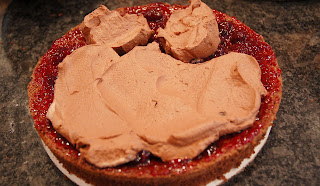I am so lucky to have been invited to spend my birthday in London with my dear friend, Ann and her family. One of the things she wanted to do there was to have me make scones with a few friends of hers. Never having made them before, I knew I would have to do some homework ahead of time. When I first thought about blogging about scones, I thought there would be a clear distinction between American scones and British ones, but I soon found that there really isn't a standard recipe, regardless of country of origin. Scones are buttery, baking powder biscuits. After that basic fact, anything seemed to go - amounts of flour, butter, sugar, liquid and leavening varied greatly. Even the pronunciation isn't universal. Americans tend to say 'sc-oh-ns, while Brits are just as likely to say 'sc-oh-ns' as 'sc-ah-ns.
I was certainly thrilled that prior to our class, Ann wanted to take me to Brown's Hotel for their world-famous High Tea. High Tea at Brown's consists of a beautiful array of finger sandwiches, scones with clotted cream and fresh strawberry jam, an assortment of finger pastries and two cakes served from a trolley - and of course, your choice of tea!
All of the food was wonderful, but I was especially impressed by the scones and pastries. I rarely eat pastry out because it so often doesn't live up to my expectations. But these were all wonderful. We asked for the recipe for the scones, and were a little surprised when the communications person delivered it to our table. We were even more pleased and surprised when the pastry chef, Fabien Ecuvillon, also came out to talk with us about his pastries.
 |
| Me with pastry chef Fabien Ecuvillon at Brown's Hotel |
It is fine food like this that has kept visitors coming to Brown's for more than a century. If you plan on going to Brown's for High Tea, be sure to make a reservation, which you can do directly from their website: http://www.brownshotel.com/, or 020 7518 4155 ( in case you're wondering, this is a completely unsolicited rave review!)
Brown's scones are a little different from the average scone, whether British or American. They are tiny, round scones and have a more tender, cakey texture than the scones you find in the supermarket or bakeries in London (this is most likely because Chef Ecuvillon mixes in the butter until no longer visible, rather than the others who mix it in more chunkily). The round shape is definitely traditional - chef Ecuvillon told us that he'd probably be out of a job if he made them wedge-shaped! Wedge-shaped ones are easier to make, and you don't have any scraps to re-roll the way that you do with round ones. Scones made from scraps are a little denser, and Chef Ecuvillon always discards the scraps so that each scone is always perfect.
For our class the next day, we decided to try and replicate Brown's scones. We made them in the traditional round shape (we did re-use the scraps), and in the easier wedge-shape. Our British scones came out great. They weren't quite as pretty as Chef Ecuvillon's, but they were delicious. When I made them at home in North Carolina, however, they really didn't come out well. The reasons for this, along with American measurements and details will follow in part 2.
Brown's Hotel Scones
500 grams plain flour
17 grams baking powder
2 grams salt
100 grams cold, diced unsalted butter
100 grams sugar
250 ml cold milk
60 grams sultanas
For egg wash
2 large egg yolks
10 ml milk
pinch sugar
Place the flour, baking powder and salt into a large bowl. Add the diced butter, and using your fingertips, rub the butter into the flour until it is no longer visible. Stir in the sugar.
Toss the sultanas into the above mixture. Make a well in the mixture and pour in all of the milk. Stir with a spoon until the mixture starts to come together.
Turn the mixture onto a lightly floured surface, and knead gently, 5 or 6 times, until it forms a smooth, soft dough. Form the dough into a round and wrap in cling wrap and chill for 1 hour.
Preheat the oven to 200 degrees C. or Gas Mark 6. Line a baking sheet with parchment paper.Roll the dough gently on a floured surface to about 2.5 cm. thick. Dip a 5cm cookie cutter into flour, and then cut out the rounds, dipping the cutter as needed. Press together scraps and re-cut. Place the rounds on the parchment paper.
Alternatively, you can shape the dough into two 8-inch rounds and cut the rounds of dough into 8 wedges.
Make the egg wash, by mixing the ingredients together in a small bowl. Brush the tops of the scones with the egg wash.
Bake for 8-10 minutes, until the scones are golden brown and look and feel cooked on the sides. Let the scones cool until just barely warm, and serve with Devonshire Clotted Cream (recipe follows in Part 3, and fresh strawberry jam.
 |
| From left: Rhonda, me, Ann-my friend and our hostess, and Gail |






























